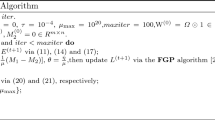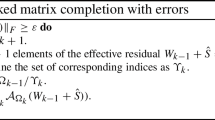Abstract
Recovering a low-rank matrix from some of its linear measurements is a popular problem in many areas of science and engineering. One special case of it is the matrix completion problem, where we need to reconstruct a low-rank matrix from incomplete samples of its entries. A lot of efficient algorithms have been proposed to solve this problem and they perform well when Gaussian noise with a small variance is added to the given data. But they can not deal with the sparse random-valued noise in the measurements. In this paper, we propose a robust method for recovering the low-rank matrix with adaptive outlier pursuit when part of the measurements are damaged by outliers. This method will detect the positions where the data is completely ruined and recover the matrix using correct measurements. Numerical experiments show the accuracy of noise detection and high performance of matrix completion for our algorithms compared with other algorithms.




Similar content being viewed by others
References
Absil, P.A., Gallivan, K.A.: Trust-region methods on Riemannian manifolds. Found. Comput. Math. 7(3), 303–330 (2006)
Balzano, L., Nowak, R., Recht, B.: Online identification and tracking of subspaces from highly incomplete information. In: 48th Annual Allerton Conference on Communication, Control, and Computing (Allerton), 2010, pp. 704–711 (2010)
Boumal, N., Absil, P.A.: RTRMC: A Riemannian trust-region method for matrix completion. In: Twenty-Fifth Annual Conference on Neural Information Processing Systems, Grenade (2011)
Cai, J., Candès, E.J., Shen, Z.: A singular value thresholding algorithm for matrix completion. SIAM J. Optim. 20, 1956–1982 (2010)
Cai, J., Osher, S.: Fast singular value thresholding without singular value decomposition. In: UCLA CAM Report, pp. 10–24 (2010)
Candes, E.J., Li, X., Ma, Y., Wright, J.: Robust principal component analysis? J. ACM 58(1), 1–37 (2009)
Candès, E.J., Recht, B.: Exact matrix completion via convex optimization. Found. Comput. Math. 9, 717–772 (2008)
Candès, E.J., Tao, T.: The power of convex relaxation: near-optimal matrix completion. IEEE Trans. Inf. Theory 56(5), 2053–2080 (2010)
Dai, W., Kerman, E., Milenkovic, O.: A geometric approach to low-rank matrix completion. IEEE Trans. Inf. Theory 58(1), 237–247 (2012)
Dai, W., Milenkovic, O., Kerman, E.: Subspace evolution and transfer (SET) for low-rank matrix completion. IEEE Trans. Signal Process. 59(7), 3120–3132 (2011)
Dong, B., Ji, H., Li, J., Shen, Z., Xu, Y.: Wavelet frame based blind image inpainting. Appl. Comput Harmon. Anal. 32(2), 155–312 (2012)
Elden, L.: Matrix Methods in Data Mining and Pattern Recognition. Society for Industrial and Applied Mathematics, Philadephia (2007). doi:10.1137/1.9780898718867
Fazel, M., Hindi, H., Boyd, H., Boyd, S.P.: A rank minimization heuristic with application to minimum order system approximation. Proc. 2001 Am. Control Conf. Cat No. 01CH37148 6(2), 4734–4739 (2001)
He, J., Balzano, L., Lui, J.C.S.: Online robust subspace tracking from partial information, arXiv: 1109.3827 (preprint) (2011)
Jain, P., Meka, R., Dhillon, I.: Guaranteed rank minimization via singular value projection. Adv. Neural Inf. Process. Syst. 23, 937–945 (2010)
Ji, H., Huang, S., Shen, Z., Xu, Y.: Robust video restoration by joint sparse and low rank matrix approximation. SIAM J. Imaging Sci. 4(4), 1112–1142 (2012)
Ji, H., Liu, C., Shen, Z., Xu, Y.: Robust video denoising using low rank matrix completion. In: IEEE Conference in Computer Vision and Pattern Recognition (CVPR), San Francisco, CA (2010)
Keshavan, R., Montanari, A.: Regularization for matrix completion. In: 2010 IEEE International Symposium on Information Theory Proceedings (ISIT), pp. 1503–1507. Boston (2010)
Keshavan, R., Montanari, A., Oh, S.: Matrix completion from a few entries. IEEE Trans. Inf. Theory 56(6), 2980–2998 (2010)
Keshavan, R.H., Montanari, A., Oh, S.: Low-rank matrix completion with noisy observations: a quantitative comparison. In: Proceedings of the 47th Annual Allerton Conference on Communication, Control, and Computing, Allerton’09, pp. 1216–1222. IEEE Press, Los Alamitos (2009)
Linial, N., London, E., Rabinovich, Y.: The geometry of graphs and some of its algorithmic applications. Combinatorica 15, 215–245 (1995)
Ma, S., Goldfarb, D., Chen, L.: Fixed point and Bregman iterative methods for matrix rank minimization. Math. Program. 128(1–2), 73–122 (2011)
Meyer, G., Bonnabel, S., Sepulchre, R.: Linear regression under fixed-rank constraints: a Riemannian approach. In: 28th International Conference on Machine Learning (ICML), Washington (2011)
Recht, B., Fazel, M., Parrilo, P.A.: Guaranteed minimum-rank solutions of linear matrix equations via nuclear norm minimization. SIAM Rev. 52(3), 471–501 (2010)
Toh, K.C., Yun, S.: An accelerated proximal gradient algorithm for nuclear norm regularized linear least squares problems. Engineering 117543(3), 1–31 (2009)
Vandereycken, B.: Low-rank matrix completion by Riemannian optimization (preprint) (2011)
Waters, A.E., Sankaranarayanan, A.C., Baraniuk, R.G.: Sparcs: Recovering low-rank and sparse matrices from compressive measurements. In: Neural Information Processing Systems (NIPS). Granada, Spain (2011)
Wen, Z., Yin, W., Zhang, Y.: Solving a low-rank factorization model for matrix completion by a nonlinear successive over-relaxation algorithm. Rice University CAAM Technical Report TR1007, pp. 1–24 (2010)
Yan, M.: Restoration of images corrupted by impulse noise using blind inpainting and \(\ell _0\) norm, UCLA CAM Report 11-72 (under review) (2011)
Yan, M., Yang, Y., Osher, S.: Robust 1-bit compressive sensing using adaptive outlier pursuit. IEEE Trans. Signal Process. 60(7), 3868–3875 (2012)
Acknowledgments
This work is supported by NSF Grant DMS-0714945, Center for Domain-Specific Computing (CDSC) under the NSF Expeditions in Computing Award CCF-0926127, ONR Grant N00014-11-1-0719, N00014-08-1-119 and an ARO MURI subcontract from Rice University.
Author information
Authors and Affiliations
Corresponding author
Appendix
Appendix
This appendix provides the mathematical proofs of the theoretical results in Sect. 4.
1.1 Proof of Theorem 1
Proof
When we overestimate \(K\), the \(K\) outliers will be found to make the objective function 0. Therefore, we only need to consider the \((p-K)\) correct entries. In the mean time, some non-outliers (the overestimated \(\varDelta K\) entries) are also considered as outliers and will not be used for MC. As we know, if the number of given entries in one row (or column) is less than \(r\), the reconstructed matrix is not unique. Since \(\varDelta K\) of the \((p-K)\) known entries will not be used in reconstructing the matrix, when \(\varDelta K\) is large enough to make the number of known entries in one row (or column) less than \(r\), we will have more than one solution. It is easily seen that the smallest number of known entries in one row (or column) of the matrix is less than or equal to \(\lfloor (p-K)/m\rfloor \) (or \(\lfloor (p-K)/n\rfloor \)), here \(\lfloor x\rfloor \) is the largest integer that does not exceed \(x\). Without loss of generality, let us assume column \(j\) has the smallest number of known entries. It is obvious that this number is bounded by \(\min (\lfloor (p-K)/m\rfloor , \lfloor (p-K)/n\rfloor )\). To make the number of known entries in this column no less than \(r\), the smallest number of entries to be deleted should not exceed \(\min (\lfloor (p-K)/m\rfloor , \lfloor (p-K)/n\rfloor )-r+1\). Thus if \(\varDelta K\) is greater than \(\min (\lfloor (p-K)/m\rfloor , \lfloor (p-K)/n\rfloor )-r\), the reconstructed matrix will not be unique.
1.2 Proof of Theorem 2
Proof
Since the probability that a certain location is chosen is fixed and equals \(q\!=\!(p-K)/ (mn)\). In addition, whether one entry is chosen or not is independent of other entries. The number of known entries in each row (or column) of this matrix follows binomial distribution. For each row, the cumulative distribution can be expressed as
where \(X\) is the number of known entries in this row.
From the Hoeffding’s inequality, we have
for any integer \(k\le nq\). Since the distribution of the number of known entries in each row is independent, we can find the upper bound for the probability that there exists one row with at most \(k\) given entries:
Here \(k_i^r\) stands for the number of given entries in the \(i^{th}\) row. Similarly the upper bound for the probability that there exists one column with at most \(k\) given entries can be expressed as follows:
where \(k_j^c\) is defined as the number of given entries in the \(j\) th column. Combing these two together, we have
which means the probability that there exists one row or column with at most \(k\) given entries can be bounded by \(2\max (P_1,P_2)\).
Let us first assume \(P_1>P_2\). Defining
we then have
When \(P_1<P_2\), we have
We define \(K_1\) as the minimal of these two values. Hence given \(P_0\), the probability of having one row or column with at most \(K_1\) entries is less than \(P_0\).
Besides the Hoeffding’s inequality, we also have Chernoff’s inequality,
In this case
After similar calculation, we have
for \(P_1>P_2\), and
when \(P_1<P_2\). Similarly we define \(K_2\) to be the smaller one of these two values, and the probability of having one row or column with at most \(K_2\) entries is less than \(P_0\). Combining the results from two inequalities together, we know that with at most \(P_0\) probability there exists one row or column with at most \(\max (K_1,K_2)\) given entries.
Rights and permissions
About this article
Cite this article
Yan, M., Yang, Y. & Osher, S. Exact Low-Rank Matrix Completion from Sparsely Corrupted Entries Via Adaptive Outlier Pursuit. J Sci Comput 56, 433–449 (2013). https://doi.org/10.1007/s10915-013-9682-3
Received:
Revised:
Accepted:
Published:
Issue Date:
DOI: https://doi.org/10.1007/s10915-013-9682-3




